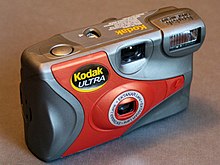Disposable camera
Disposable cameras (even disposable cameras called) are simple viewfinder cameras where the film can not be changed normally. They are given as a whole to the photo laboratory, where the camera is opened and the film inserted there is developed. The empty camera housings are either disposed of or collected by the photo laboratory and, if necessary, provided with a new film by the manufacturer of the single-use camera and put on the market again. Since usually a commercially available 35mm film with cartridge is used, some hobbyists open their disposable cameras themselves after use and equip them with a new film.
The first single-use cameras (product name Quicksnap ) were developed by Fujifilm and launched on the market in the early 1990s. They consisted of a tightly glued cardboard housing with a fixed focus plastic lens and a simple viewfinder. Models with an integrated flash light followed later . Today, single-use cameras are offered by many manufacturers, they largely correspond to the design developed by Fuji. As a rule, 35mm film with 27 images is used, occasionally also the pocket film , which is hardly used today . There are also models with a plastic housing that can be used underwater to a limited extent (at a depth of one to three meters).
From the beginning, single-use cameras were criticized because of the problematic disposal due to the material mix of paper, plastic, electronic components and batteries . The first fully recyclable single-use camera was developed and launched by Fujifilm in 1986 . Disposable cameras were able to establish themselves as "occasional cameras" for snapshots and "reserve cameras" (e.g. in the car in the event of an accident). Individually printed, they are also widely used as promotional gifts .
The German journalist Philipp Abresch used the comparatively low price of single-use cameras in several projects for “photojournalism from below”. In 1999 he distributed single-use cameras to children in Kosovo . This triggered a project in cooperation with the GTZ under the patronage of Yoko Ono . Disposable cameras were distributed to around 500 children in 45 countries and asked to take pictures with them on April 30th. This resulted in the traveling exhibition “Imagine, your photos will open my eyes”. In early 2004 Abresch distributed 170 single-use cameras to children, young people and US soldiers in Baghdad . More than 3500 photos were taken.
Next to the shutter button there is usually a counter that shows how many photos are still unexposed. So it is counted down. The film is usually transported by hand with a wheel.
